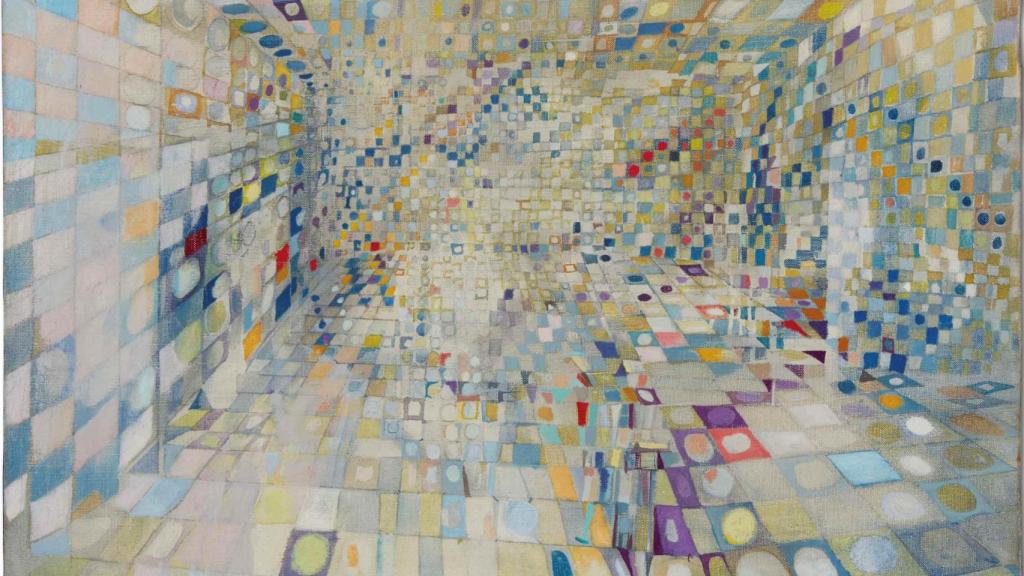“Sometimes, when I work well, I feel like I’m turning into a Lewis Carroll character. I’ve done my best work in the moments when I’ve become small: I’m finally on the same scale as the painting! That’s where I place myself. It’s a way of being in space.”
This was stated by Maria Helena Vieira da Silva (Lisbon, 1908 – Paris, 1992) to her friend and collector Trevelyan in 1937. When she was little, the artist got lost in a labyrinth and this experience, far from being traumatic, was fixed in his memory like a axis of the world a grid where the world fits.
From there he created a narrative of soft architectures: spaces that expand and melt, that impose themselves, suffocating, between the constructive and the fragmentary.
Look at the first painting that illustrates this text. It is titled The card game and it is from 1937. When he painted it, he had been living in Paris for eight years, where he had moved with his mother to continue his art studies at the Académie de la Grande Chaumière, where Giacometti and Richier swarmed as assistants.
There she met her future husband, the Hungarian painter Árpád Szenes, with whom she would maintain a relationship of true love for the rest of her life. He never overshadowed her while she stood out (In 1937 he had already sold his first painting to Solomon R. Guggenheim through Hilla von Rebay, advisor, first director and founder of the museum of the same name).
Maia Helena Vieira da Silva: ‘The card game’, 1937. Photo: Maria Helena Vieira da Silva, VEGAP, Bilbao 2025
The cards of The card game They are deconstructed in a dizzying hallucinatory movement. They are reminiscent of the eighth chapter of Alice in Wonderland, when the queen catches some card gardeners painting some white roses red and exclaims: “Off with his head!” And, if you look closely, on the left you may see the first emojis of smiling faces –smiley– from the history of painting 🙂
The dancing decks, the game of chess, the checkerboard and the harlequin dance are direct influences of The card players by Cezanne. Da Silva sifts reality through the big themes –the modern metropolis and its architecture– which are repeated over and over again in its 50 years of production. Its strokes dissolve into thousands of lines that, in turn, become millions of squares that are neither more nor less than the entire world tiled in Portuguese tiles.
Vieira da Silva: ‘Composition’, 1936. Photo: Maria Helena Vieira da Silva, VEGAP, Bilbao 2025
“I think I’ve lived my whole life in mazes. “It is my way of being in the world,” she stated. The artist lived by and for painting. She went daily to the workshop, where she happily locked herself away for hours; we can say that it was her obsession. Her origins in a wealthy Lisbon family, educated at home as an only child, had provided her with considerable knowledge of the history of art; she knew in depth the problems of perspective, scale, color, lace…, and she worked on them with devotion.
“When I start a painting, I like to have it for at least a year. Sometimes much longer, until I find the solution. I work on several projects at the same time, even while answering the phone or receiving someone.”
A solitary sniper, the artist does not belong to any movement but knew how to apprehend them all
World War II forced the couple to move to Brazil in September 1940. Szenes, who was Jewish, even converted to Catholicism to remain in Portugal, but was still denied citizenship. In Brazil, Da Silva fell into a state of deep sadness.
The news of the war, the longing for his mother and the suffocating weather lead to a suicide attempt which she survived, although anguish and anxiety accompanied her for the rest of her life. The artist channeled her pain through art. It once again incorporates the human figure, which had previously disappeared.

Maria Helena of Silva: ‘The Wolf’s Interest, 1948.
Tragedy becomes its great theme. Now he makes fascinating pieces like Shipwreck (1944), which you can see at the bottom, or The firefrom the same year. They are suffocating, motley compositions, full of the horror of the void. Infinite brush strokes and lines intersect in undulating movements that drag and trap the characters – that is, all of humanity – in graphic cells. Background and form merge in the same hallucinatory experience.
His painting resonates with multiple artistic movements. At the age of fourteen he had already read the futuristic manifestowhich would inspire her in her centrifugal compositions, full of circular movements. Traveling to Italy and Renaissance painting would also deeply mark her.
He studied Paolo Uccello and Piero della Francesca in depth, with their linear perspective, their sense of depth, their colors and the contraction of pictorial space – especially in the paintings dedicated to Battle of San Romanowhere the knights’ spears draw various vanishing points on the same canvas.
There also seems to be something from Klee, Munch, Kandinsky… Play search for them when you walk through the Guggenheim and delight in their infinite and delicious details.
Maria Helena Vieira da Silva: ‘Naufragio’, 1944 . Photo: Maria Helena Vieira da Silva, VEGAP, Bilbao 2025
This exhibition reveals to us an overwhelming painter, who displays her own, authentic gaze. Vieira da Silva is a lone sniper who does not belong to any specific artistic movement, but knew how to grasp them all.
Its world maps, its infinite grids and its invisible cities emerge as labyrinths built for escape, cages that become compasses, networks that trap you at the same time they free you.

![Baselitz: 'Nylon parade [Desfile de medias]'2022. Photo: Museum of Fine Arts of Bilbao](https://ckh.enc.edu/wp-content/uploads/2025/11/Vieira-da-Silva-the-painter-who-did-not-belong-to.jpg)